Side openings
The lateral openings (in English lateral raise, side raise or shoulder fly) are one of the fundamental exercises for the development of the lateral head of the deltoide.
Although the correct "basic" movement is relatively simple to perform, it is quite common to observe completely incorrect, and above all dangerous, executions in the gym. In this article we are going to see how to correctly perform this movement in a safe and effective way.
How are they performed?
The exercise can be performed in different variations, which we will review starting with the most common one, namely the side lift proper.
1. The "classic" side openings
It starts from the standing position, with legs slightly apart (usually shoulder-width apart), abducted shoulder blades, and dumbbells at the side of the body (and not in front). The legs can be kept slightly flexed, or straight while keeping the buttocks contracted.
The dumbbells are then raised laterally, keeping the elbows locked, not tense but slightly flexed, with the palms facing downwards, up to a maximum height corresponding to an abduction of the arm up to 90 ° (arms parallel to the ground ).
A disadvantage of the classic side raises is that in the position with the most adducted arms (i.e. close to the hips) the tension caused by the force of gravity is minimal, and consequently the work on the deltoid will also be such.
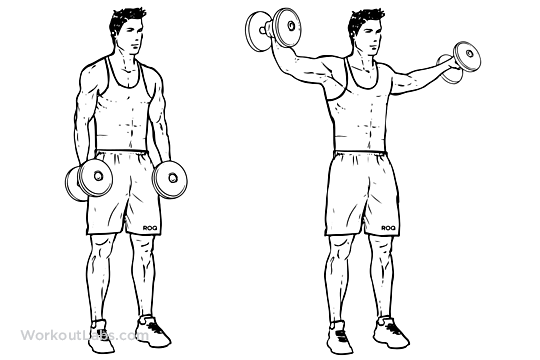
2. The side openings to "L" or "L-lateral raise"
The execution is practically identical to the previous one, with the difference that the elbows are kept locked in a more flexed position, so as to form a 90 ° angle between the biceps and forearm; this leads to a shortening of the lever arm, and the load will be lighter.
This movement it is an interesting variant that focuses the work on the external rotation muscles.
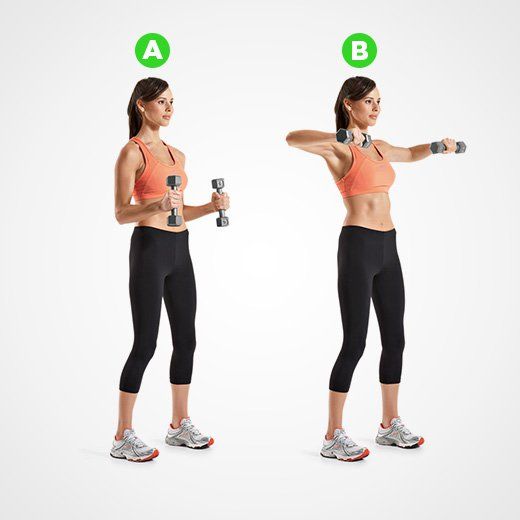
3. The side openings when seated
Almost all side lift movements can be done while seated; being an exercise that does not require excessive loads, this position can be safe and advantageous, especially to limit cheating and promote muscle isolation.
It can be performed on a 90 ° inclined bench or simply sitting without using a backrest, trying to keep the back in its natural curvature.
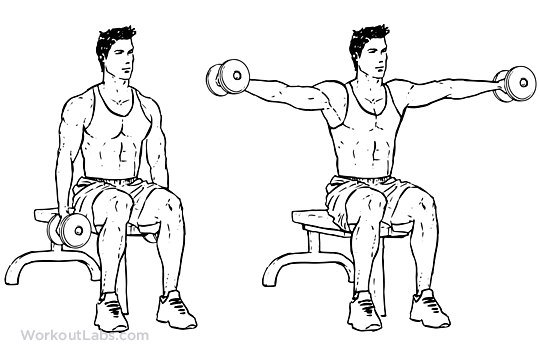
4. The side openings on the incline bench
You position yourself prone up a bench inclined by about 75 °, resting the chest on the backrest and raising the arms as described for the other variants, but one arm per set.
Among the various types of lateral lift it is probably one of the most interesting, as it allows to exclude a large part of the stabilizing muscles (for example the lumbar muscles) and allow greater muscle isolation (this is evident from the lower loads that will be able to be lifted).
Furthermore, this method would seem to reduce the risk of subacromial impingement, favoring the isolation of the lateral deltoid, and reducing the involvement of the anterior deltoid in favor of the posterior one.
Unlike the classic side raises, by performing the raises on an inclined bench, the effect of gravity occurs throughout the range of motion, allowing constant deltoid work.
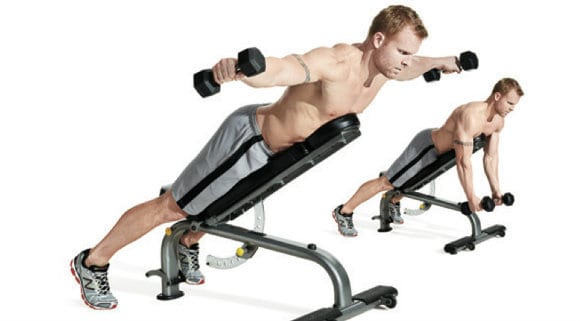
5. The openings lateral in lateral decubitus
They are similar to the previous ones in that they should be carried out by positioning lying on one side, on an inclined bench of about 30-45 ° (or even flat).
In this movement the effect of gravity is greatest when the arms are positioned close to the hips, but becomes minimal when the abduction is close to 90 °; therefore the effort is greater in the initial phase of the movement, and decreases as we raise the arms upwards.
Therefore it can be performed by stopping at a degree of abduction of about 45 °.
From the point of view of muscle recruitment, in fact, from electromyographic analyzes it emerges that with this execution, maintaining the abduction levels described above, there is little, if any, involvement of the levator shoulder muscles. However, it also emerged that with this exercise the work on the deltoid is considerably less, and carried out above all by the rotator cuff.
For this reason we can say that the lateral raises in lateral decubitus are a more useful exercise for the rotator cuff rather than the deltoid.
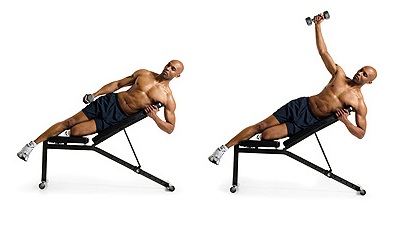
6. The side openings to the cables
Almost all the lateral lifting movements can be performed on the cables, with good results since, being the resistance provided by the cable, and not directly by gravity, the tension exerted on the muscle is constant.
However, from electromyographic analyzes it has been seen that the muscle activation of the deltoid in this exercise occurs only after 60 ° of abduction, while before most of the movement is carried out by the rotator cuff.
In particular, overall, although the muscle activation of the deltoid is similar to that which occurs in lateral raises with the dumbbells, the latter are better.
7. Lateral raise machine
Of all the lateral lift variants, those that can be carried out on the machine are potentially the least advantageous; in fact, although the machinery may be advanced and allow a certain adjustment of the station, the movement allowed is restricted and not very physiological.
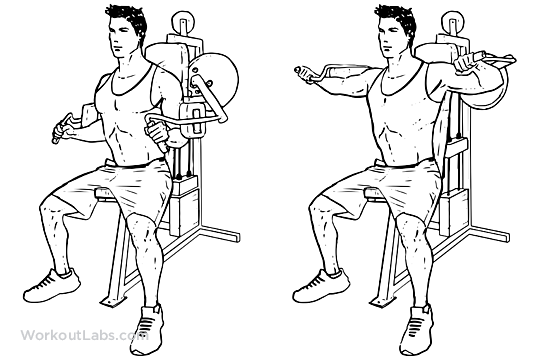
Extrarotation vs Intrarotation
The side openings are an apparently simple exercise, which however over the years has opened numerous debates in the sports field, dividing practitioners and coaches between those who recommend a neutral grip, those with internal rotation and those with external rotation.
Starting from the basics of biomechanics and orthopedics we can say that:
- Abduction of the humerus in internal rotation (internal rotation of the humerus) represents the technique that increases, more than the others, the risk of injuries deriving from sub-acromial impingement; the same applies in case of excessive external rotation.
- Abduction in partial external rotation (external rotation of the humerus), on the other hand, represents the safest modality compared to the others.
However the latter tends to divert work from the medial to the anterior deltoid.
Therefore, definitively, the best compromise in terms of muscle activation and joint health in the healthy, trained subject, would be represented by the neutral grip, with the palms facing down (remembering, in reality, that extrarotation and internal rotation they must be characteristics of the humerus and not of the wrist, which will simply be rotated as a consequence).
An excellent, effective and safe variant consists in performing the lateral lift exercise in neutral grip, but stopping at a degree of abduction of about 70-80 °.
Other common mistakes to avoid when doing side lifts:
- Protract the head forward: provides unnecessary and dangerous stress on the cervical spine;
- Raise the arms beyond 90 ° of abduction without maintaining a grip in external rotation;
- Start with the dumbbells in front of the body, rather than to the side; this error causes more than half of the movement to be regulated by the rotator cuff and not by the deltoid, which will only come into play after about 60 ° of abduction.
Conclusions
The side openings are an exercise that we could define as fundamental for the development of shoulder muscles.
However, instead of being fooled by incorrect techniques, handed down in gyms as a legacy of some old school schools of thought, let's rather rely on the scientific knowledge in our possession, and perform the exercise with all due precautions, customizing it according to our anatomical characteristics.


























